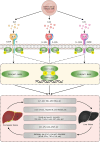Review of the potential value of serum interleukin levels as prognostic biomarkers of liver failure
- PMID: 39328855
- PMCID: PMC11326103
- DOI: 10.12998/wjcc.v12.i27.6045
Review of the potential value of serum interleukin levels as prognostic biomarkers of liver failure
Abstract
Liver failure (LF) is prevalent in China and is characterized by complex pathogenesis, challenging clinical management, poor prognosis, and rising incidence and mortality rates. The immune status is an important factor affecting LF prognosis. Interleukins (Ils) are a type of cytokine that act and interact with multiple cells, including immune cells. These signaling molecules play important roles in intercellular information transmission, including the regulation of immune cells; mediation of the activation, proliferation, and differentiation of T and B cells; and orchestration of the inflammatory response. To date, many studies have explored the correlation between IL expression and liver disease prognosis, but few studies have evaluated Ils as the prognostic biomarkers of LF. This article reviews the potential use of Ils as the prognostic biomarkers of LF. Particularly, it evaluates the predictive values of IL-21, IL-22, and IL-31, the three often overlooked yet promising prognostic biomarkers, in predicting susceptibility to LF. Harnessing biomarkers for early prognostic insights can facilitate tailored treatment strategies and enhance patient survival. Thus, this article focuses on the identification of IL-21, IL-22, and IL-33 as biomarkers in preclinical and clinical studies on LF and reviews their role as biomarkers in the pathogenesis and diagnosis of LF.
Keywords: Biological markers; Interleukin-21; Interleukin-22; Interleukin-31; Liver failure; Potential value.
©The Author(s) 2024. Published by Baishideng Publishing Group Inc. All rights reserved.
Conflict of interest statement
Conflict-of-interest statement: The authors have no conflicts of interest to declare.
Figures



References
-
- Shah S, Goldberg DS. Acute-on-chronic liver failure: update on pathogenesis, therapeutic targets, predictive models, and liver transplantation. Curr Opin Gastroenterol. 2021;37:173–178. - PubMed
-
- Kok B, Karvellas CJ. Management of Cerebral Edema in Acute Liver Failure. Semin Respir Crit Care Med. 2017;38:821–829. - PubMed
-
- Bernal W, Wang Y, Maggs J, Willars C, Sizer E, Auzinger G, Murphy N, Harding D, Elsharkawy A, Simpson K, Larsen FS, Heaton N, O'Grady J, Williams R, Wendon J. Development and validation of a dynamic outcome prediction model for paracetamol-induced acute liver failure: a cohort study. Lancet Gastroenterol Hepatol. 2016;1:217–225. - PubMed
Publication types
LinkOut - more resources
Full Text Sources

